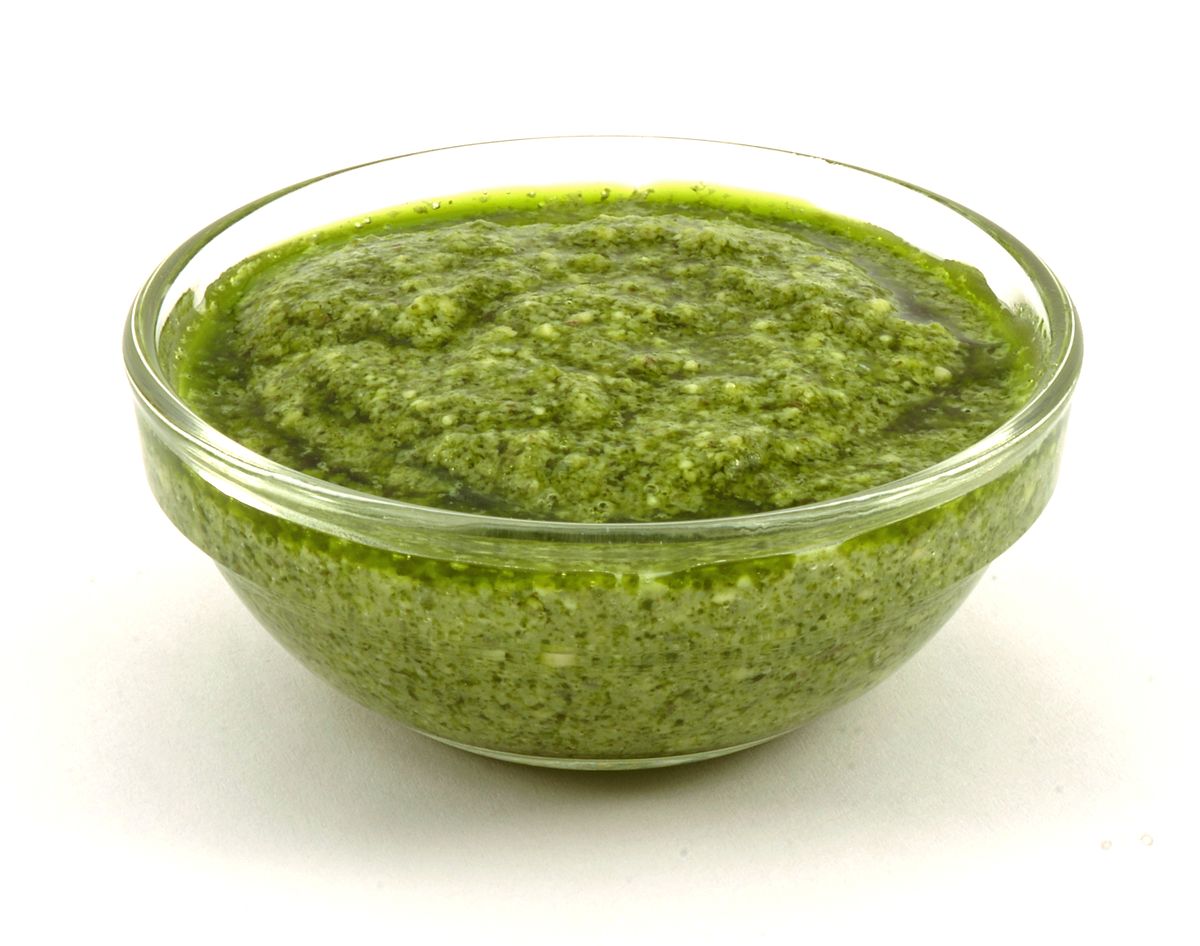Let’s find out ‘What Are Pesto’s Nutritional Values And Health Benefits?’ Genoa, Italy is the place where pesto, a thick, green sauce, first appeared. Pesto has a robust, deep flavor that it gets from its traditional ingredients of garlic, pine nuts, basil, cheese, and olive oil.
This excellent sauce has several uses, including pasta sauce, delightful dip, pizza sauce, spread, and salad dressing.
Most grocery stores provide prepared pesto, including some vegan options. While the nutritional content of store-bought and handmade pesto sauces might differ, pesto is often a rich source of good fats.
Pesto can be included in a balanced diet because it’s made with wholesome ingredients. Additionally, it fits into the Mediterranean Diet.
Pesto Nutrition Facts
The United States Department of Agriculture (USDA) FoodData Central has provided this nutritional data for 1 tablespoon (16g) of pesto. 1
| Pesto Nutrition Facts | |
|---|---|
| Calories | 92 |
| Fat | 9.5g |
| Sodium | 158mg |
| Carbohydrates | 0.9g |
| Fiber | 0.2g |
| Sugars | 0.11g |
| Protein | 1.4g |
| Calcium | 33.1mg |
| Phosphorus | 36.8mg |
| Potassium | 31.8mg |
| Magnesium | 9.76mg |
Carbs
Pesto has little under 1 gram of carbs per tablespoon. Insignificant amounts of sugar, dietary fiber, or complex carbs can be found in pesto. But it frequently goes with foods high in carbohydrates, like pasta, pizza, and sandwiches.
Fats
Olive oil, cheese, and pine nuts are the sources of fat in pesto, which makes up over 60% of its caloric content. Each spoonful contains 9.47 grams of fat, including 5.63 grams of monounsaturated fat, 1.53 grams of saturated fat, and 1.68 grams of polyunsaturated fat.
There are 2.56 mg of cholesterol in pesto. The 2020–2025 U.S. Dietary Guidelines for Americans recommend that between 20% and 35% of daily calories come from fat. 2
Protein
Pesto is not a high-protein food, containing 1.38 grams of protein per tablespoon. It can be used to flavor other foods that are higher in protein since it is regarded as a condiment.
Vitamins And Minerals
Usually, little amounts of pesto are eaten. Some people might eat more than one dish. There are some nutrients there. 33.1 mg of calcium, 36.8 mg of phosphorus, 31.8 mg of potassium, and 9.76 mg of magnesium are all present in pesto.
Calories
Just under 92 calories are found in a tablespoon of pesto made with parmesan cheese, basil, olive oil, salt, garlic, and pine nuts. Fats account for more than half of the calories.
Health Benefits
Olive oil, in particular, is one of the ingredients in pesto that may have some health advantages. Here are a few possible health advantages of pesto.
May Have Antioxidant Properties
Antioxidants are abundant in basil, garlic, pine nuts, olive oil, and olives. Antioxidant-rich diets may lower the risk of several illnesses, including cancer and heart disease.
Antioxidants are essential in protecting against the disease-causing effects of free radical damage. Regularly eating foods like pesto that are high in antioxidants may help the body produce more antioxidants, which may help it fight disease.
May Have Cardiovascular Benefits
The decreased risk of heart disease may be one of the many health advantages of olive oil. The risk of heart disease and stroke may be reduced by replacing other high-fat foods like margarine, butter, dairy, and mayonnaise with olive oil. 3
May Help Lower Cholesterol
Saturated fats, trans fats, monounsaturated fats, and polyunsaturated fats are the four distinct kinds of fats. While foods high in monounsaturated and polyunsaturated fats, such as pesto, can assist reduce LDL cholesterol levels in the blood and can promote HDL (regarded as “good” cholesterol) levels, saturated fats may increase your LDL cholesterol levels (known as “bad” cholesterol). 4
May Help With Weight Management
Traditional Italian cuisine like pesto is a staple of the Mediterranean diet. According to research, eating a Mediterranean-style diet can result in long-term changes in weight and waist size. 5 Pesto can be included in a wholesome lifestyle that promotes effective weight management.
Allergies
Parmesan cheese, a dairy product, and pine nuts, a tree nut, both of which are known food allergies, are usually used in pesto. People who are allergic to dairy and nuts may experience an adverse response.
While some people may take pine nuts and parmesan cheese, care is suggested. Hives, swelling, itching, shortness of breath, nausea, vomiting, trouble swallowing, and dizziness are some of the signs of food allergies. 6
If you encounter symptoms related to food allergies, you should speak with a healthcare professional. To identify the dietary allergens to which you are allergic, the physician might do a skin test.
Adverse Effects
Pesto from the store may include a lot of salt. Before including these products in their diet, those who are on a low-sodium diet or who take any heart medications ought to consult their doctor. Consider creating a homemade pesto recipe that uses less salt if you want to manage the sodium content of your dish.
Varieties
Pesto comes in a wide variety in grocery shops. Vegans can hunt for cheese- and dairy-free pesto sauces even though it is a vegetarian-friendly condiment. Nut-free options are also available for those who have nut allergies.
While basil is the primary herb in pesto, other herbs may also be used to make certain products. Try making your own pesto from scratch using a recipe that suits your dietary needs if you want more control over the ingredients.
Storage And Food Safety
For up to five days, keep homemade pesto in the refrigerator in an airtight container. Verify the expiration or best before dates on the label of the pesto container you purchased at the shop.
How To Prepare
Any dish can be topped with pesto as a sauce if you like. However, it can also be used as a dip, salad dressing, sandwich spread, and other things. It is primarily associated with Italian foods like pasta and pizza.











